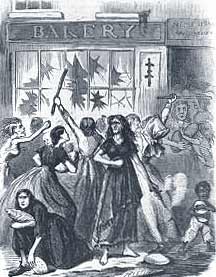Southern bread riots
 Bread riots in Richmond | |
| Date | April 2, 1863 |
|---|---|
| Location | Confederacy |
| Participants | Mostly women |
The Southern bread riots were events of civil unrest in the Confederacy during the American Civil War, perpetrated mostly by women in March and April 1863. During these riots, which occurred in cities throughout the South, women and men violently invaded and looted various shops and stores.[1]
Causes
The riots were triggered by the women's lack of money, provisions, and food.[2] All were the result of multiple factors:
- Inflation had caused prices to soar while incomes had not kept pace.[3]
- Refugees had flooded the cities causing severe shortages of housing and overwhelming the old food supply system. Richmond's population tripled from 38,000 people in 1860 to over 100,000 by 1863.[4][5]
- Food supplies in rural areas were running short and less food was exported to cities; foraging armies, both Union and Confederate, ravaged crops and killed farm animals.[6]
- Many cities—especially Richmond—were at the end of long supply lines, and internal transportation became increasingly difficult.[7]
- The drought of 1862 resulted in a poor harvest in a time when food was already scarce.
- Salt, which at the time was the only practical meat preservative, was very expensive (if available at all) because it was generally an imported item. The Union blockade prevented imports, and the capture of Avery Island, Louisiana, with its salt-mine, exacerbated the problem.[8]
As in the French Revolution, citizens, mostly women, began to protest the exorbitant price of bread. The protesters believed a negligent government and speculators were to blame. To show their displeasure, many protesters turned to violence. In Richmond; Columbus, Georgia, Macon, Atlanta, and Augusta armed mobs attacked stores and warehouses. In North Carolina, mobs destroyed grocery and dry goods stores.[9]
Food riots were occurring before the arrival of Union troops because the Confederate army was suffering the same food shortages and was taking food stocks for its own needs. Additionally, as the cost of war for the Confederate government exceeded the tax revenue, legislation was enacted that exacerbated the situation by devaluing the Confederate currency and inflating prices of goods.
Richmond bread riots
On April 2, 1863, in the Confederate capital of Richmond, Virginia, about 5,000 people, mostly poor women, broke into shops and began seizing food, clothing, shoes, and even jewelry before the Militia arrived to restore order. Tens of thousands of dollars worth of items were stolen. No one died and few were injured.[10] The riot was organized and instigated by Mary Jackson, a huckster and the mother of a soldier.[11]
President Jefferson Davis pleaded with the women and even threw them money from his pockets, asking them to disperse, saying "You say you are hungry and have no money; here, this is all I have". The mayor read the Riot Act; the governor called out the militia, and it restored order.[12]
See also
References
- ↑ Michael B. Chesson, "Harlots or Heroines? A New Look at the Richmond Bread Riot." Virginia Magazine of History and Biography 92#2 (1984): 131-175. in JSTOR
- ↑ Mary Elizabeth Massey, "The food and drink shortage on the Confederate homefront." North Carolina Historical Review 26.3 (1949): 306-334. in JSTOR
- ↑ Eugene M. Lerner, "Money, prices, and wages in the Confederacy, 1861-65." Journal of Political Economy (1955): 20-40. in JSTOR
- ↑ Mary Elizabeth Massey, Refugee Life in the Confederacy (1964).
- ↑ Alfred Hoyt Bill, The Beleaguered City: Richmond, 1861-1865 (1946) p 3
- ↑ Andrew F. Smith, Starving the South: How the North Won the Civil War (Macmillan, 2011).
- ↑ Robert C. Black, The railroads of the Confederacy (1952).
- ↑ Mark Kurlansky, Salt: A World History
- ↑ The Salisbury Bread Riot
- ↑ Chesson, 1984
- ↑ "Bread or Blood: The Richmond Bread Riot - Hungry History". HISTORY.com. Retrieved April 13, 2017.
- ↑ Katherine R. Titus, "The Richmond Bread Riot of 1863: Class, Race, and Gender in the Urban Confederacy" The Gettysburg College Journal of the Civil War Era 2#6 (2011) pp 86-146
Further reading
- Chesson, Michael B. "Harlots or Heroines? A New Look at the Richmond Bread Riot." Virginia Magazine of History and Biography 92#2 (1984): 131-175. JSTOR 4248710
- Grady, John (April 5, 2013). "Richmond Bread Riot". New York Times.
- Hurt, R. Douglas. Agriculture and the Confederacy: Policy, Productivity, and Power in the Civil War South (U North Carolina Press, 2015).
- Lerner, Eugene M. "Money, prices, and wages in the Confederacy, 1861-65." Journal of Political Economy (1955): 20-40. JSTOR 1826773
- McPherson, James M. (1988). Battle Cry of Freedom: The Civil War Era. Ballantine Books; Random House Publishing Inc. ISBN 0-345-35942-9.
- Kurlansky, Mark. Salt: A World History.
- Rable, George C. Civil Wars: Women and the Crisis of Southern Nationalism (U of Illinois Press, 1989).
- Smith, Andrew F. Starving the South: How the North Won the Civil War (Macmillan, 2011).
- Titus, Katherine R. "The Richmond Bread Riot of 1863: Class, Race, and Gender in the Urban Confederacy" The Gettysburg College Journal of the Civil War Era 2#6 (2011) pp 86–146 online
- Williams, Teresa Crisp, and David Williams. "'The Women Rising': Cotton, Class, and Confederate Georgia's Rioting Women." Georgia Historical Quarterly 86.1 (2002): 49-83. JSTOR 40584640